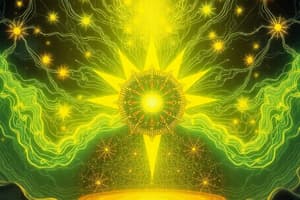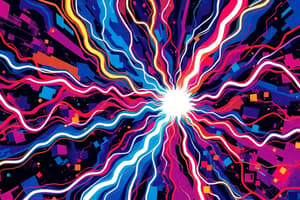Podcast
Questions and Answers
What is the primary role of potential difference in an electrical circuit?
What is the primary role of potential difference in an electrical circuit?
- To serve as a pathway for current
- To convert electric energy into thermal energy
- To act as the driving force that pushes the current (correct)
- To resist the flow of current
What happens when like poles of magnets are brought together?
What happens when like poles of magnets are brought together?
- They form a temporary magnet
- They repel each other (correct)
- They attract each other
- They create a magnetic field
Which statement accurately describes respiration in living organisms?
Which statement accurately describes respiration in living organisms?
- It releases energy by combining food with oxygen (correct)
- It involves converting light energy into chemical energy
- It is a process that stores energy for later use
- It occurs only in plants
What determines the strength of an electromagnet?
What determines the strength of an electromagnet?
What is the primary function of current in an electrical circuit?
What is the primary function of current in an electrical circuit?
The ______ contains the DNA in an animal cell and controls the cell's activities.
The ______ contains the DNA in an animal cell and controls the cell's activities.
Match the letter label on the animal cell diagram to the name of the structure.
Match the letter label on the animal cell diagram to the name of the structure.
Match the plant cell structure with a description of its function.
Match the plant cell structure with a description of its function.
In a plant cell from a root, you would not expect to find ______, as these trap light so they wouldn't be needed in cells underground.
In a plant cell from a root, you would not expect to find ______, as these trap light so they wouldn't be needed in cells underground.
What is the equation for voltage?
What is the equation for voltage?
What is the equation of photosynthesis?
What is the equation of photosynthesis?
What is the equation for respiration?
What is the equation for respiration?
Flashcards
What is electric current?
What is electric current?
The flow of electric charge through a circuit.
What is potential difference?
What is potential difference?
The force that pushes electric current through a circuit.
What is an electromagnet?
What is an electromagnet?
A temporary magnet created by electric currents flowing through a coil of wire.
What is photosynthesis?
What is photosynthesis?
Signup and view all the flashcards
What is respiration?
What is respiration?
Signup and view all the flashcards
What is a cell?
What is a cell?
Signup and view all the flashcards
What is cytoplasm?
What is cytoplasm?
Signup and view all the flashcards
What is the cell membrane?
What is the cell membrane?
Signup and view all the flashcards
What is the nucleus?
What is the nucleus?
Signup and view all the flashcards
What are mitochondria?
What are mitochondria?
Signup and view all the flashcards
What is the cell wall?
What is the cell wall?
Signup and view all the flashcards
What is a vacuole?
What is a vacuole?
Signup and view all the flashcards
What are chloroplasts?
What are chloroplasts?
Signup and view all the flashcards
How are plant cells adapted?
How are plant cells adapted?
Signup and view all the flashcards
What is the function of the cell wall?
What is the function of the cell wall?
Signup and view all the flashcards
What is the function of chloroplasts?
What is the function of chloroplasts?
Signup and view all the flashcards
What is the function of vacuoles?
What is the function of vacuoles?
Signup and view all the flashcards
What is the function of the cell membrane?
What is the function of the cell membrane?
Signup and view all the flashcards
What is the function of the nucleus?
What is the function of the nucleus?
Signup and view all the flashcards
What is the function of mitochondria?
What is the function of mitochondria?
Signup and view all the flashcards
How do plant cells differ from animal cells?
How do plant cells differ from animal cells?
Signup and view all the flashcards
How are root and leaf cells specialized?
How are root and leaf cells specialized?
Signup and view all the flashcards
Are plant cells living?
Are plant cells living?
Signup and view all the flashcards
How does the cell membrane control what enters and leaves the cell?
How does the cell membrane control what enters and leaves the cell?
Signup and view all the flashcards
How does photosynthesis use light energy?
How does photosynthesis use light energy?
Signup and view all the flashcards
How does respiration release energy from food?
How does respiration release energy from food?
Signup and view all the flashcards
How do plant cells adapt to their specific functions?
How do plant cells adapt to their specific functions?
Signup and view all the flashcards
Where are chloroplasts located?
Where are chloroplasts located?
Signup and view all the flashcards
How does the vacuole affect the shape of a plant cell?
How does the vacuole affect the shape of a plant cell?
Signup and view all the flashcards
What is the structure of the cell membrane?
What is the structure of the cell membrane?
Signup and view all the flashcards
How does the nucleus control the cell's functions?
How does the nucleus control the cell's functions?
Signup and view all the flashcards
Why are mitochondria important for both plant and animal cells?
Why are mitochondria important for both plant and animal cells?
Signup and view all the flashcards
How do photosynthesis and respiration work together in plants?
How do photosynthesis and respiration work together in plants?
Signup and view all the flashcards
Study Notes
Electrical Circuits
- Electrical circuits involve current, potential difference (voltage), and resistance.
- Current is the flow of electric charge.
- Potential difference (voltage) is the driving force that pushes the current.
- Resistance opposes the flow of current.
Electromagnets
- Electromagnets are temporary magnets created by electric currents.
- Electric currents flowing through a coil of wire create a magnetic field.
- The strength of the electromagnet depends on the current and the number of turns in the coil.
Magnetism
- Magnetism is a force that attracts or repels certain materials.
- Magnetic forces are exerted by magnets.
- Opposite poles attract, and like poles repel.
Cells
- Cells are the basic units of life.
- Cells contain the genetic information (DNA) for their functioning.
- Specialized cells perform specific tasks.
- Plant cells have some common structures with animal cells, such as the cytoplasm, cell membrane, nucleus, and mitochondria.
- Plant cells also have additional structures like the cell wall and vacuole, and some have chloroplasts.
- Plant cell structures have specific functions.
- Plant cells can have different shapes and structures.
Specialized Cells
- Specialized cells have unique structures that adapt them to specific functions (e.g., nerve, muscle, blood cells).
- Different cell types have unique structural characteristics and functions.
Photosynthesis
- Photosynthesis is the process by which plants and other organisms convert light energy into chemical energy.
- This process uses light energy to convert carbon dioxide and water into sugars.
- Chloroplasts are structures found in the green parts of plants, trapping light to enable the plant to make its own food.
Respiration
- Respiration is the process of releasing energy from food by combining it with oxygen.
- This process is essential for all living organisms.
- Respiration occurs in cells throughout the body.
- Mitochondria are involved in respiration.
Climate Change
- Climate change is the long-term shift in global temperatures and weather patterns.
- This shift is primarily caused by human activities, such as burning fossil fuels.
- Climate change impacts global ecosystems and society.
Studying That Suits You
Use AI to generate personalized quizzes and flashcards to suit your learning preferences.




